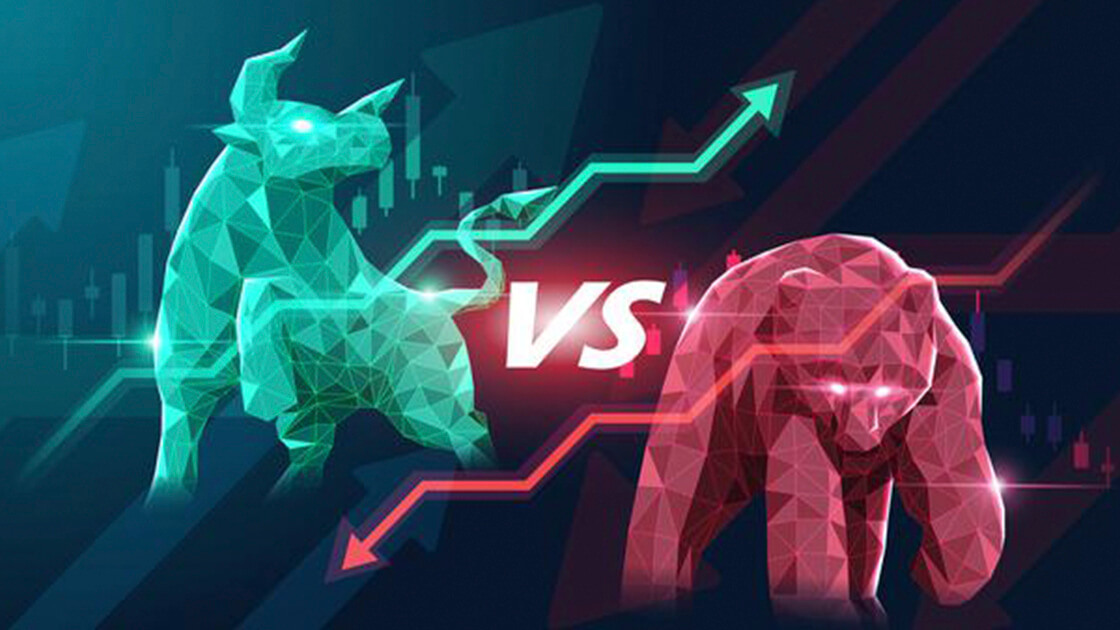Bull and Bear markets are financial terms that describe the trends and conditions of the market at a particular period of time. A bull market means that the price of the stocks is rising in terms of a longer period. A bear market is just the opposite. There is a price decrease in the market for a longer period.
Generally, it is considered to be a bull market when prices are up by 20% and a bear market when the prices decline by 20%.
Bull and bear markets refer to all the sectors of finance. This includes stocks, commodities, bonds, real estate, and the crypto industry. As for crypto, the trend may describe the performance of a definite category like stablecoins or non-fungible tokens or the run of a singular cryptocurrency like BTC, Eth, and so on.
It's important to note that markets are changing continuously and it's not always considered that reasons come from bull or bear trends. Mostly, ups and downs follow each other holding a flat market without positive or negative trends. Over time it becomes noticeable in what direction the market has been moving.
How to know if there is a bull or bear market?
There are some technical tools that can help to figure out the trend. Charts serve well to that purpose. Looking at them gives the possibility to see and get the general information about the market. Among the major indicators that are simple to analyze are:

- moving averages
In charts moving averages (MA) are mainly in the form of lines. They show the direction of the cryptocurrency performance during various time periods. For instance, a week, 20 minutes, a year, etc. Usually, users can pick the interval they want to study. So, it can be handy for both short-term and long-term traders. Moving averages don't show sudden movements as price charts do.
- price structure (pivot highs, pivot lows)
Pivot points show the high, low, and closing prices of the preceding trading sessions. Through them, users can form an idea about upcoming support and resistance levels.
Trending: Kevin O'Leary promises to increase investment in digital assets
A support level is a price that the cryptocurrency is expected to keep after a down period. Generally, there is a high demand in the case of support level as the price is attractive for both sellers and buyers, so the level prevents the following falls. However, if the price continues to decline below a support level, a bearish trend begins.
A resistance level is a reached price at which market participants are unwilling to buy the asset as there is a possibility of a decrease. Traders' behavior is decisive in what direction the market will go.
If there is a high demand and bullish moods prevail, the price will cross the resistance level and go higher. So it will reach a new resistance point, while the previous one will turn into a support mark. Meanwhile, in the case of the price going down, the previous support level may become a resistance level.
Investment strategies during bull and bear markets
In most cases, the bull and bear market impacts investment decisions. It's important to note that both trends come to the end at some point.
When there is a bull market, common choices of investing may be:
-
buying cryptocurrencies and holding them The investor intends to sell the assets later at a higher price.
-
buying and holding cryptocurrencies regularly
Trending: Salvadorans are against buying bitcoins at the expense of the budget
This suggests increased purchases while the prices are going up and presents a higher risk. -
trading at the times of retracement
In any bullish period, most likely there will be short times of declines. These intervals are known as a retracement. Some investors pick a retracement period to add their holdings so that they will benefit more if the prices continue to grow.
- trading in a full swing style
The strategy is perhaps the most aggressive one as investors choosing it trade actively. They employ different tactics like short selling to maximize their returns.
The bear market can also be beneficial. Particularly when the investment strategy is longer-term, trades done during a bear market will bring income when the rates begin to increase. For short-term investments, there will be gains when the price changes.
Trending: Support.com Stock Surges After Merger with BTC Mining Firm
More experienced investors imply the strategy of short selling which means betting on a price drop. So, they sell their assets in order to buy them back later at a reduced cost. Another popular strategy is fiat-cost averaging that suggests investing a definite amount of money every week or month no matter the asset is going up or down. Investors employ this tactic both during bull and bear markets.
The Bottom Line
While there is a bull vs bear confrontation, markets can take unexpected turns very often. So, before making a trading decision at times of significant price changes it is important to consider all the risks, possible gains, and losses.






